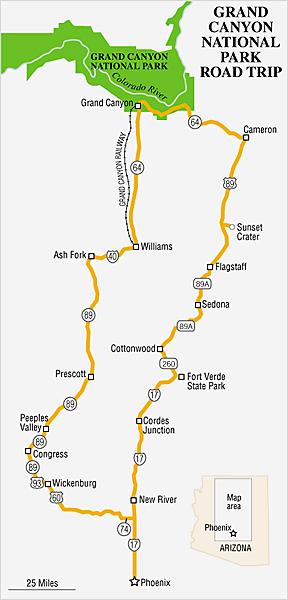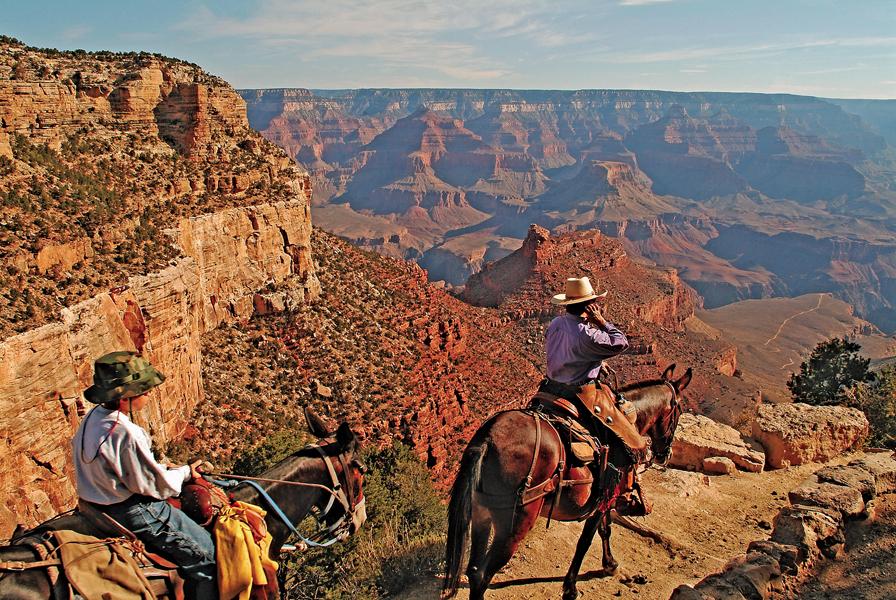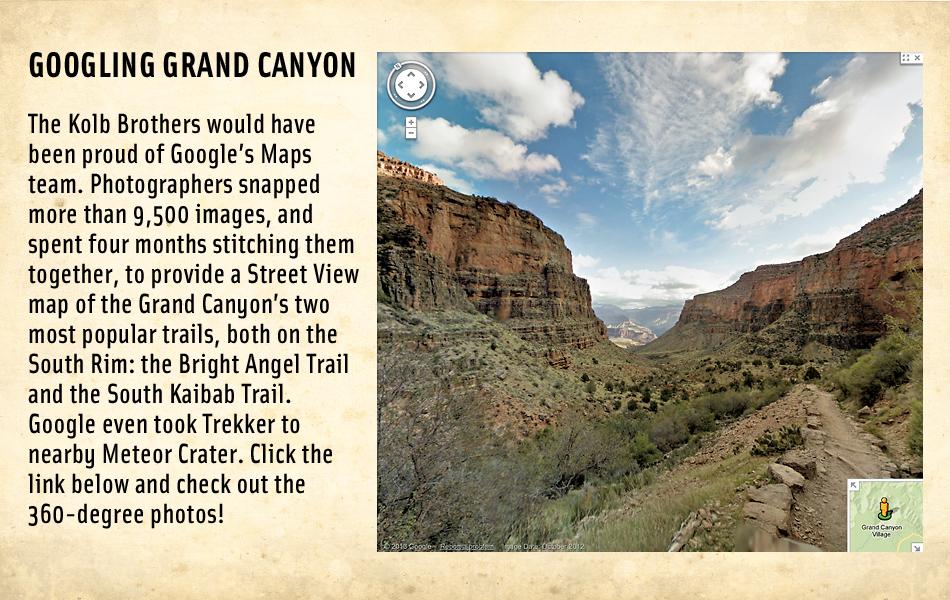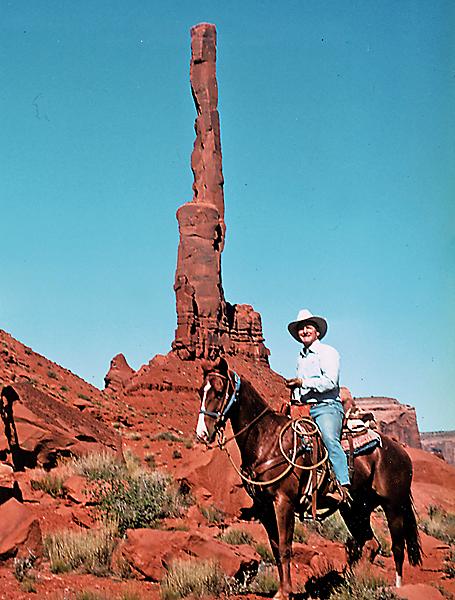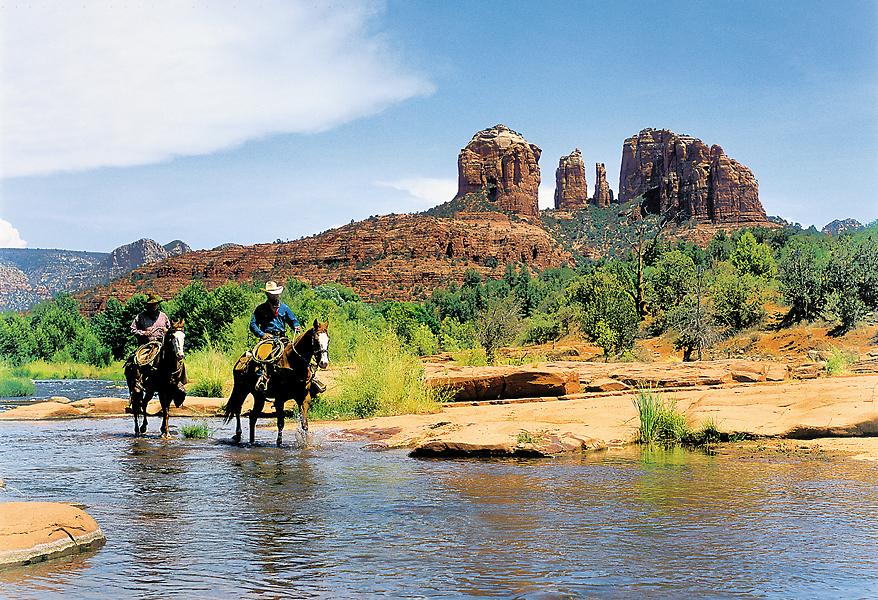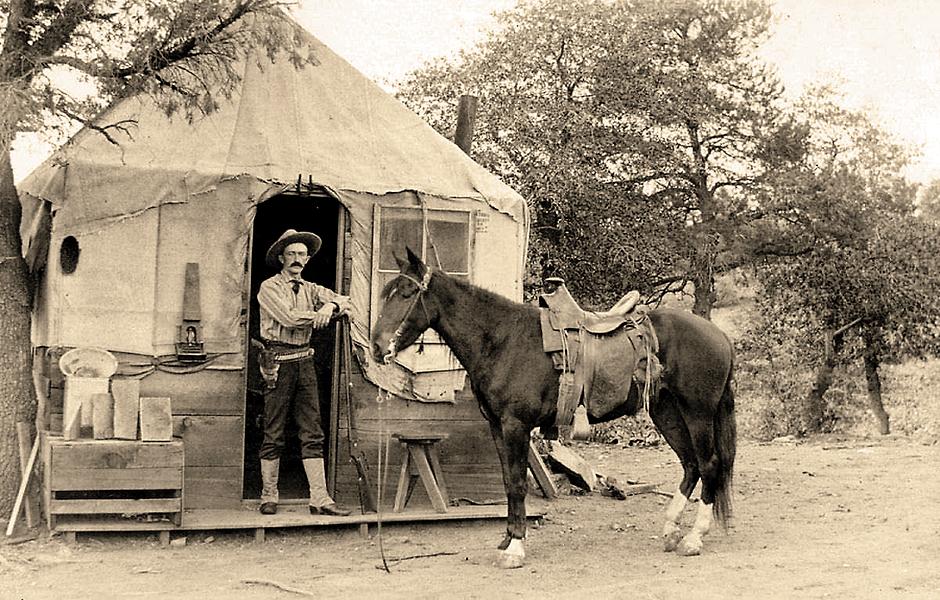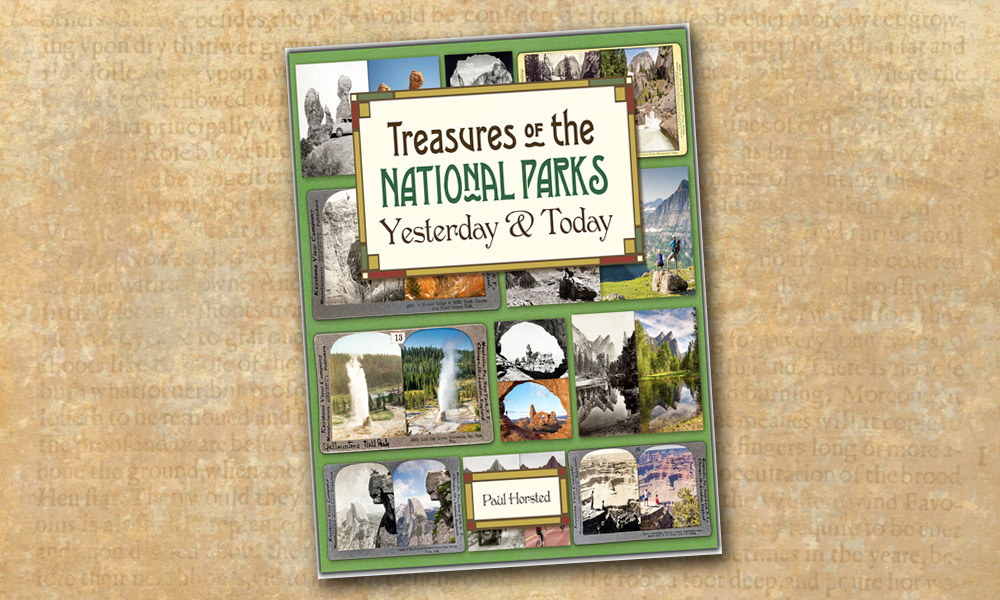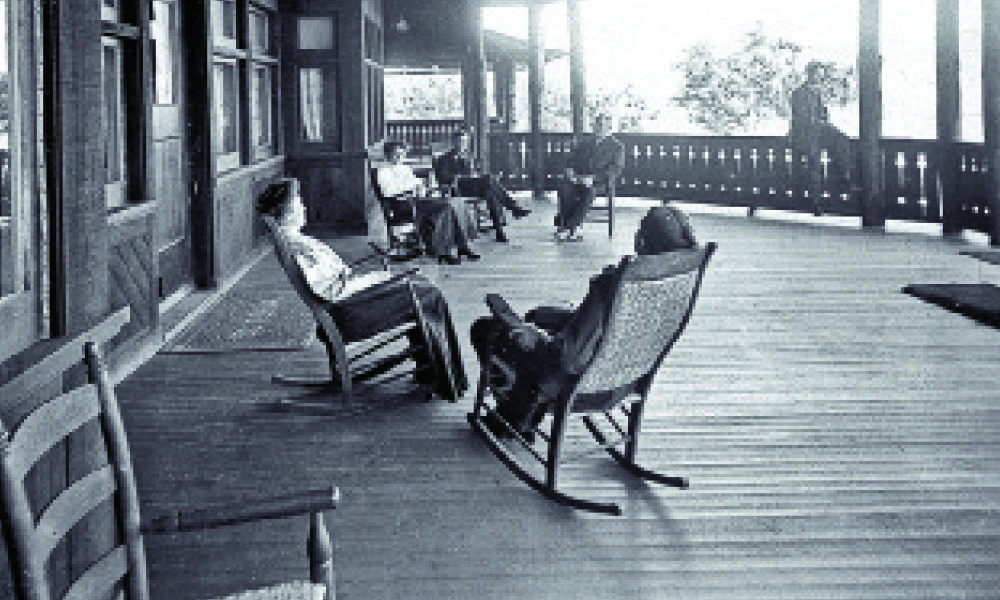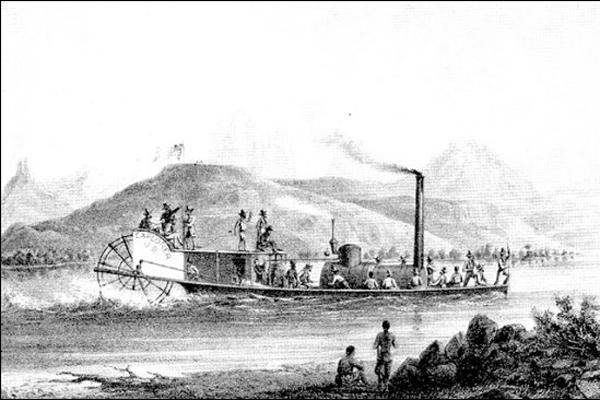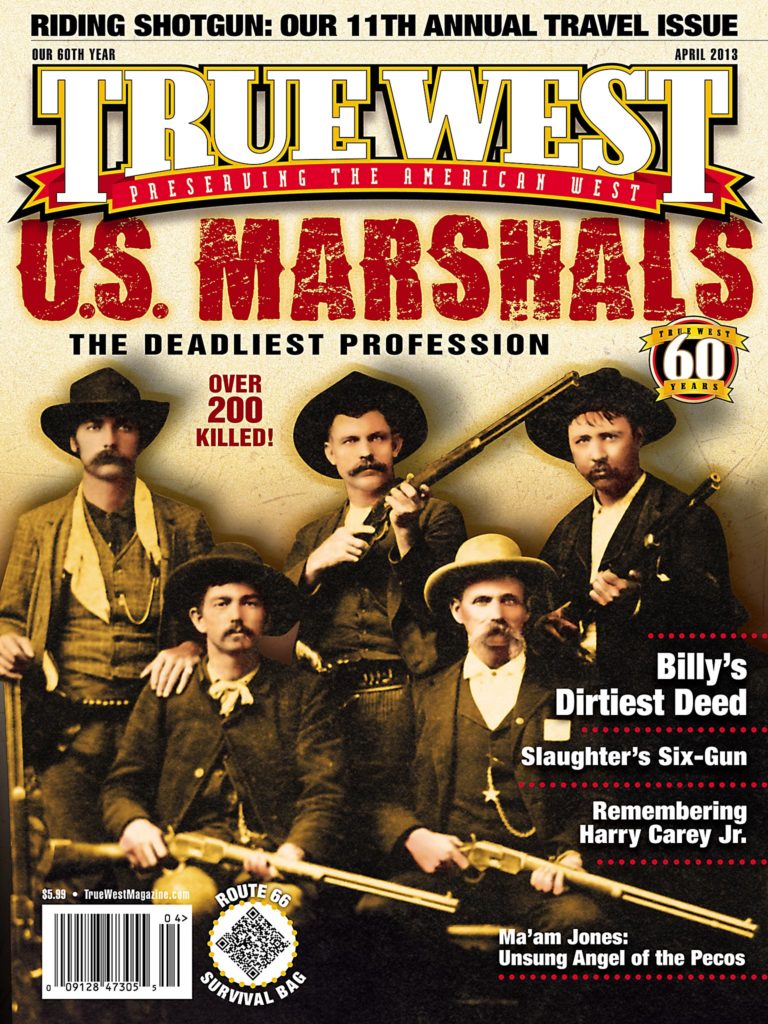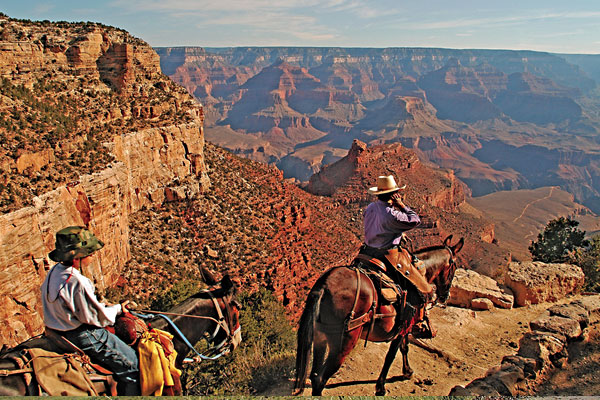 Arizona has more loops than a calf roper’s convention, and one of my favorites is the Grand Canyon Loop. If you don’t like the scenery in one place, keep going, because a few miles down the road, it’s completely different.
Arizona has more loops than a calf roper’s convention, and one of my favorites is the Grand Canyon Loop. If you don’t like the scenery in one place, keep going, because a few miles down the road, it’s completely different.
Most people start and end in the Phoenix area, taking Interstate 17 north to Route 74, a highway that takes you through beautiful Sonoran Desert scenery for 30 miles to where it joins U.S. 60 just south of Wickenburg.
MINING CAMPS GALORE
Wickenburg’s downtown offers a distinctive Old West flavor. Yours truly is the voice offering the narratives for the sidewalk statues. You’ll find incredible art by Joe Beeler, Charlie Russell and Frederic Remington at the Desert Caballeros Western Museum. I always dine at the Horseshoe Café, where the food, service and ambiance are top-notch. With Rancho de los Caballeros and other guest ranches still going strong, Wickenburg prides itself as a dude ranch capital.
Drive north to Congress, where you’ll pass near the Stanton, Octave and Rich Hill gold camps. The latter was the richest single gold strike in Arizona history. During the 1950s, Bill Esenwein prospected in the area. His rattlesnake pet fetish earned him the name as “Dr. Doolittle of Diamondbacks.”
MORE THAN WHISKEY ROW
Climb up Yarnell Hill, roll through Peeples Valley and veer toward the White Spar Mountains into the city of Prescott, the first territorial capital of Arizona and the home of the 1888 pro rodeo and storied Whiskey Row. On Whiskey Row, don’t miss these three saloons: Matt’s (for good cowboy dancing); Jersey Lilly (say “hey” to proprietor Tommy Meredith, a high school classmate of mine); and the Palace (its Brunswick bar is the oldest in the state; you haven’t been to Prescott if you haven’t bellied up to the bar at the Palace).
Just west of Whiskey Row on Gurley Street is the Sharlot Hall Museum, where something fun is always going on, from public festivals to exhibits. Many historical buildings, including the territorial governor’s log residence, are on the grounds. Not as well known, but worth a visit and just off Gurley is the Smoki Museum. It resembles a Hopi pueblo and offers exhibits focused on Southwestern indigenous art.
Gracing the front steps of the majestic Yavapai County Courthouse in the heart of town is the Rough Rider Statue honoring Teddy Roosevelt’s volunteer cavalry. The bronze, often called the “Buckey O’Neill Statue,” for Prescott’s famous sheriff who died just before the charge up San Juan Hill, was sculpted by Solon Borglum and is regarded by many as the world’s finest equestrian statue.
Hitch a ride on the Prescott Trolley to get acquainted with this historic-minded community’s preservation districts. All are worth seeing, but my favorite is the Courthouse Plaza featuring restored Victorian homes bounded by Gurley, Goodwin, Montezuma and Cortez Streets. (I also recommend you take in a show at the Elks Opera House.)
On your way out of Prescott, check out the artworks at the Phippen Museum, named for George Phippen, a founder of the Cowboy Artists of America (he and three other artists formed the organization in Sedona).
Gateway to grand canyon
Proceed north across Chino Valley and Hell Canyon to follow the stagecoach trail from Prescott to Ash Fork. From Ash Fork, head east, where you’ll find, nestled at the foot of Bill Williams Mountain, the picturesque town of Williams, named for the famous mountain man. The Santa Fe began laying tracks north to the Grand Canyon in 1901 to open up this region as the “Gateway to the Grand Canyon.”
Riding the rails on the Grand Canyon Railway is still the best way to reach this wonder of the world. Crew and strolling musicians regale passengers with Grand Canyon folklore and history, while faux train robbers surprise and excite the kids. The train delivers you to the edge of the South Rim. I’ve visited the canyon dozens of times, yet each time, I stand mesmerized, staring in awe at the timeless chasm.
“ONE GREAT SIGHT”
President Theodore Roosevelt expressed his feelings about the Grand Canyon in a plea for preservation: “Do nothing to mar its grandeur…keep it for your children, your children’s children and all who come after you, as the one great sight which every American should see.”
Others have been less poetic in their commentary: “Today, I spit a mile,” wrote a youngster in the park’s guest registry.
“What a marvelous place to throw your mother-in-law,” mused a French politician.
A cowboy reckoned, “It’d be a helluva place to lose a cow.”
My favorite place to stay here is the venerable El Tovar, perched on the edge of the great abyss. Built in 1905 from local limestone and Oregon pine, this blend of Swiss Chalet and Scandinavian hunting lodge was one of the most elegant hotels west of the Mississippi. A stone’s throw away is the Hopi House, designed by Fred Harvey architect, Mary Jane Colter, based on the Hopi village, Old Oraibi.
Four museums on the South Rim are must-sees: Kolb’s Photography Studio (Emery and Ellsworth Kolb were the first to film a Grand Canyon river run); Lookout Studio (also designed by Colter); Tusayan Ruin; and the Yavapai Geology Museum.
RUINS & PEAKS
Now it’s time to head for the home stretch. Pass through the Cameron Trading Post, with its Navajo rugs, Hopi kachinas and Pueblo pottery. Then visit the spectacular red-hued Sinagua prehistoric ruins at Wupatki. Close by is Sunset Crater, the site of the last volcanic eruption in Arizona, roughly 900 years ago.
The towering San Francisco Peaks will be to the west. The tallest, Humphreys Peak, at 12,633, is the highest point in Arizona. At the foot of the peaks is Flagstaff, first settled by Boston colonists, who hoisted a flag up a tall pine tree, on July 4, 1876.
Surrounded by some of the most beautiful country in the West, this clear mountain air town offers year-round sports and recreation. Old-timers claim Flagstaff was 40 years old before the town built a cemetery because nobody died.
Flagstaff is also the home of Northern Arizona University and all the cultural amenities it provides (check out the Museum of Northern Arizona and the Lowell Observatory, on the site chosen by Percival Lowell in 1894 to study the stars). When I visit, I stay at the Monte Vista hotel.
CALL OF THE CANYON
Next, wind down Oak Creek Canyon, also known as the “Grand Canyon with a highway running through it.” Its soaring walls and stunning beauty inspired Zane Grey to write his classic Call of the Canyon. The 1923 Jesse Lasky film based on the novel was the first of many movies to use Oak Creek and Sedona as a backdrop.
At the mouth of the canyon is Sedona, surrounded by massive red sandstone monoliths. The area, sometimes known as Arizona’s Little Hollywood, has played host to more than 60 films, including Johnny Guitar, Broken Arrow, 3:10 to Yuma, The Rounders, Angel and the Badman and Stagecoach. You can learn about its movie history and its pioneer days at the Sedona Heritage Museum.
One of the most photographed places in the state is Red Rock Crossing at Red Rock State Park. Visitors also flock to experience the vistas in a Pink Jeep Tour. Sedona draws some three and a half million visitors annually, second only to the Grand Canyon.
From Sedona, head to Cottonwood, which has evolved from being a “Bootlegging Capital” to hosting a thriving Old Town attraction with false-front buildings. Next up is Clarkdale, a company town for the “Billion Dollar Copper Camp” at Jerome. Once the fourth largest city in the territory, Jerome became an artist community after mines closed in 1953. As you drive through the Verde Valley, taste some Arizona wines at the wineries along the Verde Valley Wine Trail.
Next up is Fort Verde State Park. Built in 1866, the fort was relocated to its present location. During Gen. George Crooks’s winter campaign of 1872-73, it was a supply base for punitive expeditions into the Tonto Basin. Many of the fort’s 1880s buildings remain. Frontier military history is commemorated through annual events such as Fort Verde Days, vintage baseball games and the Corn Fest (all corntestants are welcome to share their corny jokes).
From Camp Verde, roll down I-17 and make a beeline to Phoenix. You’ll pass Cordes Junction, which runs parallel to the Black Canyon Stage Line that ran from Prescott to Phoenix (you can see some of the road from the interstate as you drop off the plateau at Sunset Point). Stagecoach robberies were a regular event on the mountainous road. In 1882, one audacious outlaw robbed northbound and southbound stages at the same time. Since his plunder exceeded expectations, he graciously returned the victim’s pocket watches and donated some of the proceeds for dinner and drinks at the next stage station.
By the time you see the New River stage station on your left, you’ll be back in the outskirts of Phoenix.
Photo Gallery
– By Scott Johnson Photography / Arizona Office of Tourism –
Marshall Trimble
– Courtesy Arizona Office of Tourism –
– Courtesy PACT / Arizona Office of Tourism –


